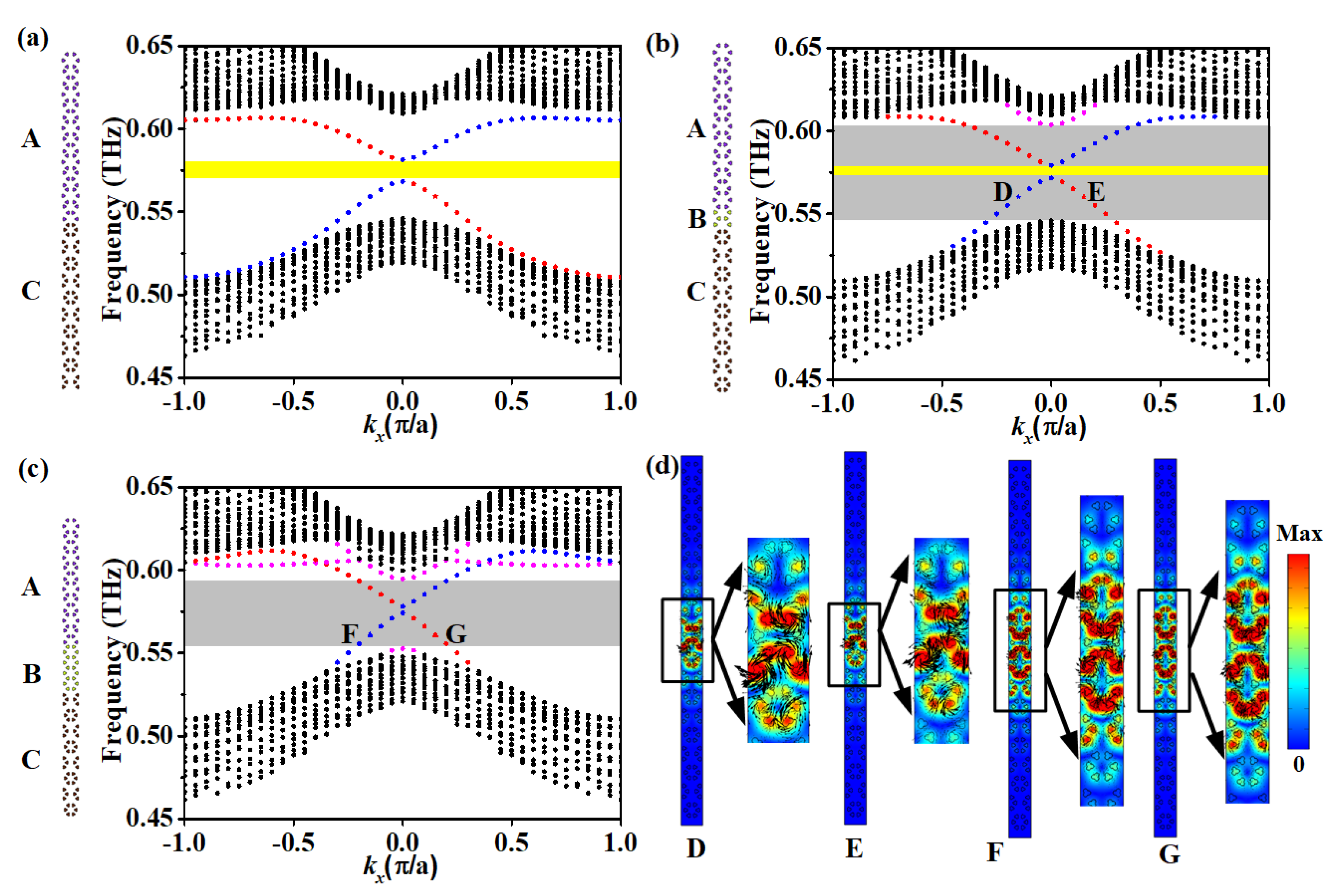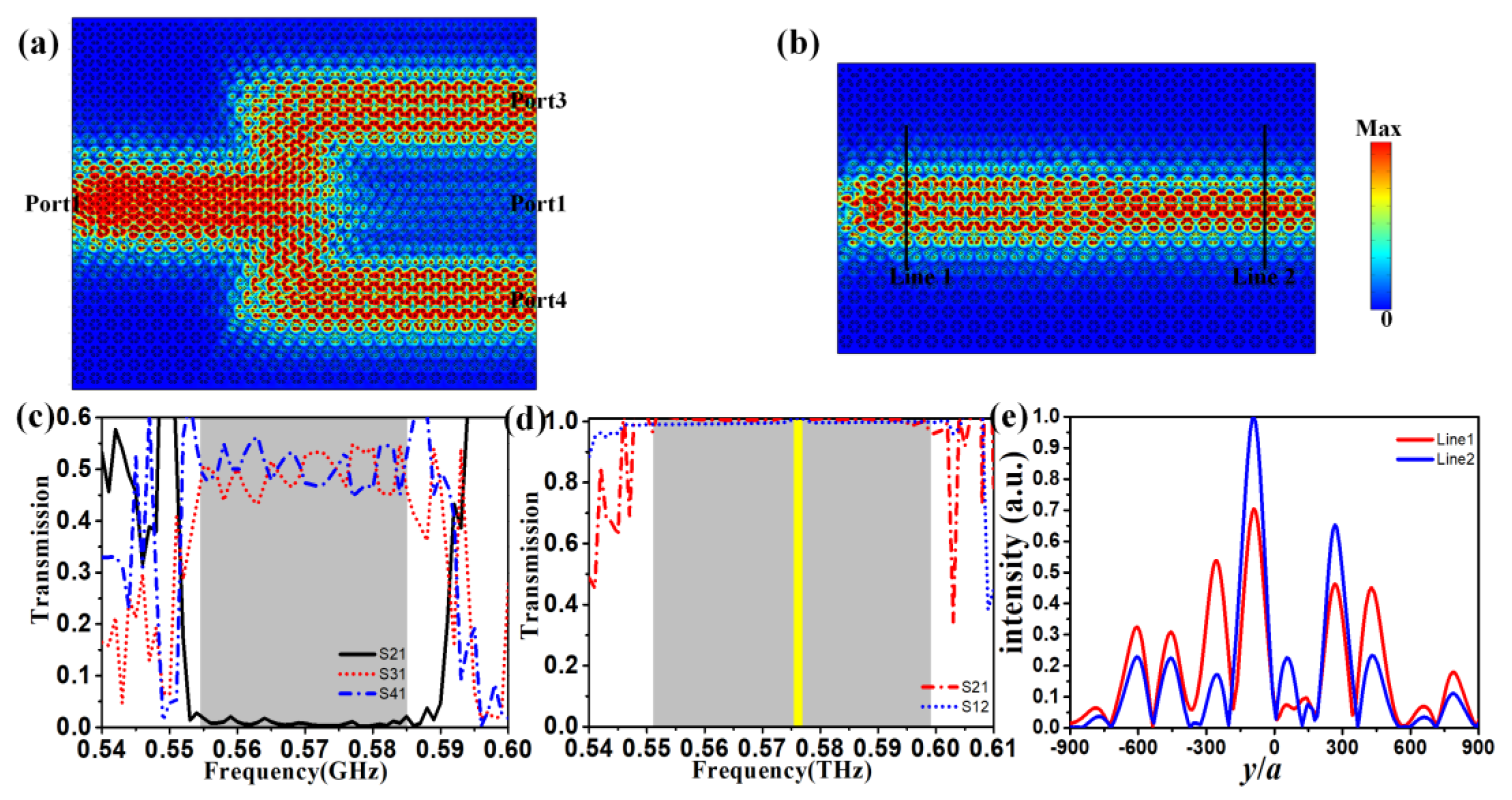Topological Large-Area Waveguide States Based on THz Photonic Crystals
Abstract
1. Introduction
2. Heterostructure-Based Structure and Band Structure Analysis of Unit Cell
3. Topological Edge States and Topological Large-Area Waveguide States

4. Spin-Momentum-Locking and Robustness Analysis of Topological Large-Area Waveguide States
5. Application of Topological Large-Area Waveguide States
6. Discussion and Conclusions
Author Contributions
Funding
Data Availability Statement
Conflicts of Interest
References
- Leitenstorfer, A.; Moskalenko, A.S.; Kampfrath, T.; Kono, J.; Castro-Camus, E.; Peng, K.; Qureshi, N.; Turchinovich, D.; Tanaka, K.; Markelz, A.G.; et al. The 2023 terahertz science and technology roadmap. J. Phys. D Appl. Phys. 2023, 56, 223001. [Google Scholar] [CrossRef]
- Jiang, W.; Guerboukha, H.; Jornet, J.M.; Mittleman, D.M.; Yang, Z. Terahertz Communications and Sensing for 6G and Beyond: A Comprehensive Review. IEEE Commun. Surv. Tutor. 2024, 26, 2326–2381. [Google Scholar] [CrossRef]
- Kumar, A.; Gupta, M.; Pitchappa, P.; Wang, N.; Fujita, M.; Singh, R. Terahertz Topological Photonic Integrated Circuits for 6G and Beyond: A Perspective. J. Appl. Phys. 2022, 132, 140401. [Google Scholar] [CrossRef]
- Hasan, M.Z.; Kane, C.L. Colloquium: Topological insulators. Rev. Mod. Phys. 2010, 82, 3045–3067. [Google Scholar] [CrossRef]
- Lu, L.; Joannopoulos, J.D.; Soljačić, M. Topological photonics. Nat. Photonics 2014, 8, 821–829. [Google Scholar] [CrossRef]
- Haldane, F.D.M.; Raghu, S. Possible Realization of Directional Optical Waveguides in Photonic Crystals with Broken Time-Reversal Symmetry. Phys. Rev. Lett. 2008, 100, 013904. [Google Scholar] [CrossRef]
- Khanikaev, A.B.; Mousavi, S.H.; Tse, W.K.; Kargarian, M.; MacDonald, A.H.; Shvets, G. Photonic topological insulators. Nat. Mater. 2013, 12, 233–239. [Google Scholar] [CrossRef]
- Wu, L.H.; Hu, X. Scheme for Achieving a Topological Photonic Crystal by Using Dielectric Material. Phys. Rev. Lett. 2015, 114, 223901. [Google Scholar] [CrossRef]
- Yang, Y.T.; Xu, Y.F.; Xu, T.; Wang, H.X.; Jiang, J.H.; Hu, X.; Hang, Z.H. Visualization of a unidirectional electromagnetic waveguide using topological photonic crystals made of dielectric materials. Phys. Rev. Lett. 2018, 120, 217401. [Google Scholar] [CrossRef] [PubMed]
- Ma, T.; Shvets, G. All-Si valley-Hall photonic topological insulator. New J. Phys. 2016, 18, 025012. [Google Scholar] [CrossRef]
- Dong, J.W.; Chen, X.D.; Zhu, H.; Wang, Y.; Zhang, X. Valley photonic crystals for control of spin and topology. Nat. Mater. 2017, 16, 298–302. [Google Scholar] [CrossRef]
- Chen, X.D.; Zhao, F.L.; Chen, M.; Dong, J.W. Valley-contrasting physics in all-dielectric photonic crystals: Orbital angular momentum and topological propagation. Phys. Rev. B 2017, 96, 020202. [Google Scholar] [CrossRef]
- Gao, F.; Xue, H.R.; Yang, Z.J.; Lai, K.F.; Yu, Y.; Lin, X.; Chong, Y.D.; Shvets, G.; Zhang, B.L. Topologically protected refraction of robust kink states in valley photonic crystals. Nat. Phys. 2018, 14, 140–144. [Google Scholar] [CrossRef]
- He, X.T.; Liang, E.T.; Yuan, J.J.; Qiu, H.Y.; Chen, X.D.; Zhao, F.L.; Dong, J.W. A Silicon-on-Insulator Slab for Topological Valley Transport. Nat. Commun. 2019, 10, 872. [Google Scholar] [CrossRef]
- Yang, Y.; Yamagami, Y.; Yu, X.; Pitchappa, P.; Webber, J.; Zhang, B.; Fujita, M.; Nagatsuma, T.; Singh, R. Terahertz topological photonics for on-chip communication. Nat. Photonics 2020, 14, 446–451. [Google Scholar] [CrossRef]
- Tang, G.J.; He, X.T.; Shi, F.L.; Liu, J.W.; Chen, X.D.; Dong, J.W. Topological Photonic Crystals: Physics, Designs, and Applications. Laser Photonics Rev. 2022, 16, 2100300. [Google Scholar] [CrossRef]
- Ma, J.; Xi, X.; Sun, X. Topological Photonic Integrated Circuits Based on Valley Kink States. Laser Photonics Rev. 2019, 13, 1900087. [Google Scholar] [CrossRef]
- Yoshimi, H.; Yamaguchi, T.; Ota, Y.; Arakawa, Y.; Iwamoto, S. Slow light waveguides in topological valley photonic crystals. Opt. Lett. 2020, 45, 2648–2651. [Google Scholar] [CrossRef] [PubMed]
- Gao, Z.; Yang, Z.; Gao, F.; Xue, H.; Yang, Y.; Dong, J.; Zhang, B. Valley surface-wave photonic crystal and its bulk/edge transport. Phys. Rev. B 2017, 96, 201402. [Google Scholar] [CrossRef]
- Noh, W.; Nasari, H.; Kim, H.-M.; Le-Van, Q.; Jia, Z.; Huang, C.-H.; Kante, B. Experimental demonstration of single-mode topological valley-Hall lasing at telecommunication wavelength controlled by the degree of asymmetry. Opt. Lett. 2020, 45, 4108–4111. [Google Scholar] [CrossRef] [PubMed]
- Zeng, Y.; Chattopadhyay, U.; Zhu, B.; Qiang, B.; Li, J.; Jin, Y.; Li, L.; Davies, A.G.; Linfield, E.H.; Zhang, B.; et al. Electrically pumped topological laser with valley edge modes. Nature 2020, 578, 246–250. [Google Scholar] [CrossRef] [PubMed]
- Gong, Y.K.; Wong, S.; Bennett, A.J.; Huffaker, D.L.; Oh, S.S. Topological Insulator Laser Using Valley-Hall Photonic Crystals. ACS Photonics 2020, 7, 2089–2097. [Google Scholar] [CrossRef]
- Wei, G.C.; Liu, Z.Z.; Zhang, D.S.; Xiao, J.J. Frequency dependent wave routing based on dual-band valley-Hall topological photonic crystal. New J. Phys. 2021, 23, 023029. [Google Scholar] [CrossRef]
- Kumar, A.; Gupta, M.; Pitchappa, P.; Tan, Y.J.; Wang, N.; Singh, R. Topological sensor on a silicon chip. Appl. Phys. Lett. 2022, 121, 011101. [Google Scholar] [CrossRef]
- Shalaev, M.I.; Walasik, W.; Litchinitser, N.M. Optically tunable topological photonic crystal. Optica 2019, 6, 839–844. [Google Scholar] [CrossRef]
- He, L.; Zhang, W.; Zhang, X. Topological all-optical logic gates based on two-dimensional photonic crystals. Opt. Express 2019, 27, 25841–25859. [Google Scholar] [CrossRef]
- Kumar, A.; Gupta, M.; Pitchappa, P.; Tan, T.C.; Chattopadhyay, U.; Ducournau, G.; Wang, N.; Chong, Y.; Singh, R. Active Ultrahigh-Q (0.2 × 106) THz Topological Cavities on a Chip. Adv. Mater. 2022, 34, 2202370. [Google Scholar] [CrossRef]
- Kumar, A.; Gupta, M.; Pitchappa, P.; Wang, N.; Szriftgiser, P.; Ducournau, G.; Singh, R. Phototunable chip-scale topological photonics: 160 Gbps waveguide and demultiplexer for THz 6G communication. Nat. Commun. 2022, 13, 5404. [Google Scholar] [CrossRef]
- Rosiek, C.A.; Arregui, G.; Vladimirova, A.; Albrechtsen, M.; Vosoughi Lahijani, B.; Christiansen, R.E.; Stobbe, S. Observation of strong backscattering in valley-hall photonic topological interface modes. Nat. Photonics 2023, 17, 386–392. [Google Scholar] [CrossRef]
- Wang, M.; Yang, Y.; Yang, Y.T.; Li, G.Y.; Lu, M.H. Valley-locked waveguide transport in acoustic heterostructures. Nat. Commun. 2020, 11, 3000. [Google Scholar] [CrossRef]
- Wang, J.Q.; Liu, S.B.; Xue, H.R.; Chong, Y.D. Extended topological valley-locked surface acoustic waves. Nat. Commun. 2022, 13, 1324. [Google Scholar] [CrossRef] [PubMed]
- Yin, S.; Li, F.; Yang, Z.J.; Zhang, X. Acoustic valley-locked waveguides in heterostructures of a square lattice. Phys. Rev. Appl. 2022, 18, 054073. [Google Scholar] [CrossRef]
- Wang, M.; Hang, Z.H.; Mei, J.; Wu, Y.; Chan, C.T. Topological one-way large-area waveguide states in magnetic photonic crystals. Phys. Rev. Lett. 2021, 126, 067401. [Google Scholar] [CrossRef] [PubMed]
- Yu, X.; Lin, Z.K.; Wang, H.X.; Jiang, J.H. Topological large-area one-way transmission in pseudospin-field-dependent waveguides using magneto-optical photonic crystals. Photon. Res. 2023, 11, 1105–1112. [Google Scholar] [CrossRef]
- Chen, Q.; Xiao, J.J.; Chen, X.D.; Chen, W.J.; Li, Y. Photonic topological valley-locked waveguides. ACS Photonics 2021, 8, 1400–1406. [Google Scholar] [CrossRef]
- Yan, S.; Zhao, D.; Yang, Y.H.; Zhang, B.L. Transport of a topologically protected photonic waveguide on-chip. Photon. Res. 2023, 11, 1021–1028. [Google Scholar] [CrossRef]
- Guo, P.-Y.; Li, W.; Hu, J.; Wang, H.-X. Dual-Band Topological Large-Area Waveguide Transport in Photonic Heterostructures. Phys. Rev. B 2024, 110, 035405. [Google Scholar] [CrossRef]
- Liu, C.; Yang, F.; Xu, S.; Li, M. Reconfigurable Metasurface: A Systematic Categorization and Recent Advances. Electromagn. Sci. 2023, 1, 0040021. [Google Scholar] [CrossRef]
- Ma, K. Regulation and Control of Electromagnetic Field in Radio-Frequency Circuits and Systems. Electromagn. Sci. 2023, 1, 0030101. [Google Scholar] [CrossRef]
- Liu, Y.; Zhang, B.; Zhang, Y. Electronically Controlled Broadband Terahertz Amplitude Modulator Based on Ionic Liquid/PEDOT: PSS: DMSO Composite Structure. J. Opt. Photonics Res. 2024, 2, 111–117. [Google Scholar] [CrossRef]
- Huang, H.; Liu, Z.; Ruggiero, M.T.; Zheng, Z.; Qiu, K.; Li, S.; Zhang, Z.; Zhang, Z. Terahertz Geoscience: THz Time-Domain Spectroscopy for Mineral Materials. Cryst. Growth Des. 2025, 25, 3578–3594. [Google Scholar] [CrossRef]
- Al-Taie, M.S.J. The Mutual Support between Bright and Dark Pulses in Photonic Crystal Fibers. J. Opt. Photonics Res. 2025, in press. [Google Scholar] [CrossRef]
- Liu, K.; Jiang, Y.; Wang, Z.; Yu, X.; Li, Y.; Wang, J.; Zhang, Y.; Wei, X.; Chen, S.; Zhao, Y.; et al. 3D Printing Colloidal Crystal Microstructures via Sacrificial-Scaffold-Mediated Two-Photon Lithography. Nat. Commun. 2022, 13, 4567. [Google Scholar] [CrossRef] [PubMed]
- Zhu, H.-T.; Xue, Q.; Hui, J.-N.; Pang, S.W. A 750–1000 GHz H-Plane Dielectric Horn Based on Silicon Technology. IEEE Trans. Antennas Propag. 2016, 64, 5074–5083. [Google Scholar] [CrossRef]
- Chudpooti, N.; Duangrit, N.; Burnett, A.D.; Freeman, J.R.; Gill, T.B.; Phongcharoenpanich, C.; Imberg, U.; Torrungrueng, D.; Akkaraekthalin, P.; Robertson, I.D.; et al. Wideband Dielectric Properties of Silicon and Glass Substrates for Terahertz Integrated Circuits and Microsystems. Mater. Res. Express 2021, 8, 056301. [Google Scholar] [CrossRef]



| Reference | Array Structure | Working Frequency | Wave Transport States | Magnetic Fields |
|---|---|---|---|---|
| 33 | Magnetic rods | GHz | Two orthogonal one-way waveguide states | Yes |
| 34 | Magnetic rods | GHz | Large-area transport states with pseudospin-field-momentum-locking | Yes |
| 35 | Metasurface | GHz | Topological large-area transport states with valley-momentum-locking | No |
| 36 | Triangular airholes | Near-Infrared | Topological large-area transport states with valley-momentum-locking | No |
| This work | Petal-shaped dielectric scatterers | THz | Topological large-area transport states with pseudospin-momentum-locking | No |
Disclaimer/Publisher’s Note: The statements, opinions and data contained in all publications are solely those of the individual author(s) and contributor(s) and not of MDPI and/or the editor(s). MDPI and/or the editor(s) disclaim responsibility for any injury to people or property resulting from any ideas, methods, instructions or products referred to in the content. |
© 2025 by the authors. Licensee MDPI, Basel, Switzerland. This article is an open access article distributed under the terms and conditions of the Creative Commons Attribution (CC BY) license (https://creativecommons.org/licenses/by/4.0/).
Share and Cite
Zhao, Y.; Liang, F.; Li, J.; Han, J.; Chen, J.; Hu, H.; Zhang, K.; Yang, Y. Topological Large-Area Waveguide States Based on THz Photonic Crystals. Photonics 2025, 12, 791. https://doi.org/10.3390/photonics12080791
Zhao Y, Liang F, Li J, Han J, Chen J, Hu H, Zhang K, Yang Y. Topological Large-Area Waveguide States Based on THz Photonic Crystals. Photonics. 2025; 12(8):791. https://doi.org/10.3390/photonics12080791
Chicago/Turabian StyleZhao, Yulin, Feng Liang, Jingsen Li, Jianfei Han, Jiangyu Chen, Haihua Hu, Ke Zhang, and Yuanjie Yang. 2025. "Topological Large-Area Waveguide States Based on THz Photonic Crystals" Photonics 12, no. 8: 791. https://doi.org/10.3390/photonics12080791
APA StyleZhao, Y., Liang, F., Li, J., Han, J., Chen, J., Hu, H., Zhang, K., & Yang, Y. (2025). Topological Large-Area Waveguide States Based on THz Photonic Crystals. Photonics, 12(8), 791. https://doi.org/10.3390/photonics12080791






